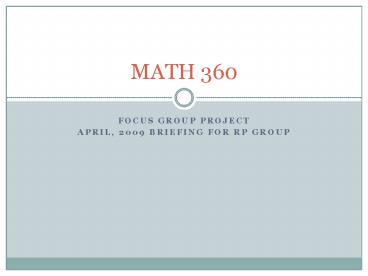Focus Group Project PowerPoint PPT Presentation
1 / 22
Title: Focus Group Project
1
MATH 360
- Focus Group Project
- April, 2009 Briefing for RP Group
2
Summary
- The Math problem
- Focus Groups
- What
- How
- Challenges
- Methods/Results Math 360 project
- Logistics
- Summary
- Handout with example student statements
3
Part 1 The Math Problem
- In general and at COS
4
Math in College
- Educators note decline in STEM disciplines
enrollments - Other countries produce more
- Standard of living and quality of life issues
- Math as a barrier to college success
- Many come poorly prepared
- Many have fear of Math
- Success rates are extremely low
- Many avoided Math until late
- Many sidetracked from disciplines requiring MATH
5
Math Sequence at COS
- Math Course Sequence
- Math 360 (Pre-algebra)
- Barrier course
- Four units/hrs
- Normally offered in a 2/2 pattern
- Three levels below college
- Math 200 (Elementary Algebra) or Math 205
(Beginning Algebra) - 360 recommended
- Math 230 (Intermediate Algebra) or higher level
- 200 or 205 required
6
Percent Who Took Math Placement
Includes only those first time students who had
declared a transfer or two year associate degree
goal.
7
Placement Test Results for First Time Students
8
Success Rate in Math 360
363
9
Unsuccessful Students Who Later Successfully
Attempted Higher Level Math Classes
363 Students Who Were Unsuccessful in Math 360
during Fall, 2006.
10
Those Who Tested into Math 360 in Fall 2005
11
Efforts to Improve Math Success at COS
- Carnegie grant emphasizes innovative
instructional methodologies - FYE integrates Math, English, and study skills
- Re-emphasis on Math tutoring center
- Research student backgrounds, course sequencing
- Despite the gloomy picture, some pass 360 and
moved on - The question what has helped you (the student)
to succeed?
12
Part 2 Focus groups
13
Why use a focus group? What is it?
- To supplement or enrich traditional findings
- We knew who werent succeeding
- We wanted to provide concrete ideas about how to
succeed - Focus group a structured group interview
- conducted in accord with a research design
- addresses one or several research questions
- A focus group is not a
- Discussion group
- Buzz session
- Problem-solving session
- Consensus building session
14
Focus group characteristics
- Participants have a common background or
experience which they bring to the group - Guided interaction address questions raised by
the facilitator, or others in the group - Motivations, feelings, values, and points-of-view
are shared - Add richness to research not possible through
surveys or one-on-one interviews
15
The structure of a typical focus group
- 60 to 90 minute session
- 6 to 10 participants seated around a table
- A facilitator or moderator
- Sessions structured in a general sense focus
on the research questions - Sessions recorded or a note taker
- Ground rules governing participant interaction
and behavior stated and strictly adhered to - Held in a quiet location
16
Role of the facilitator
- Introduces and enforces ground rules
- Structures the interaction around research
questions - Ensures individual participation using variety of
methods - Probing (explain, help us to understand, can
you be more specific or give an example) - Restating
- Eliciting views and thoughts of others in the
group - Comparing and contrasting views of particpants
- Remains neutral
17
Focus group challenges
- Can be very difficult and costly to administer
- Finding facilitators
- Avoiding participants who want to soap box
- Transcribing and synthesizing results into
meaningful findings which correspond,
supplement, or contrast with other research
findings - Selling results which do not stem from
traditional research methods - Avoiding researcher bias
18
Part 3, Methods and Results
19
Math and Research Collaborate
- Roundtable discussions with Math faculty,
February, 2008 to - Elicit support for a focus group study on 360
success - Lay out a focus group study timetable
- Define the research question
- Research question What has helped you (the
student) to succeed in Math 360? - What did your instructor do
- What did you do
- What role did Math lab and tutoring have
- What advice would you give to others
20
COS Logistics (1)
- Initiated study in April 2008
- Initial pool of 250 students who met the
criteria tested into 360, were successful in 360
and a higher level math, and were still enrolled - Pool reduced to 80
- Scheduling
- Lack of student interest
- Final scheduling further reduced the pool to 55
21
COS Logistics (2)
- Five focus sessions with 42 students
- Tested into Math 360 and were successful
- Later enrolled in a higher class and passed
- 60 minute sessions, private location
- Three facilitators
- Dialogue taped and transcribed
- Transcripts organized based on themes and
synthesized (in an inductive way) - Shared with the Math faculty in department
meetings
22
Results
- Math 360 students are not mature learners they
are not self-disciplined - Successful students in Math 360 desire/need
- Structure and discipline
- Step-by-step methods
- Mandatory homework
- Mandatory Math lab or tutoring
- Unequivocal student expectations
- Instructor-offered choices/options can be
counterproductive

